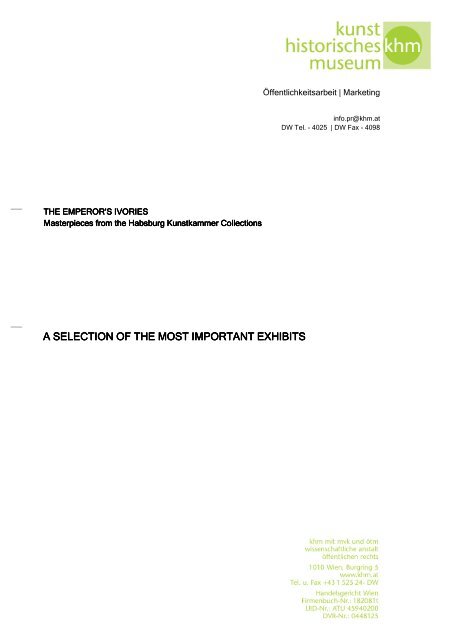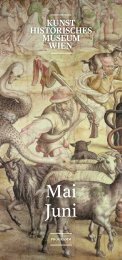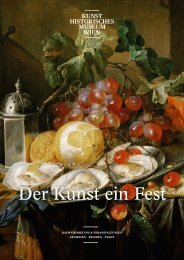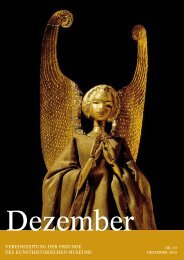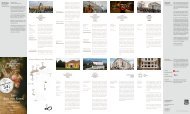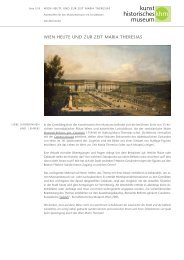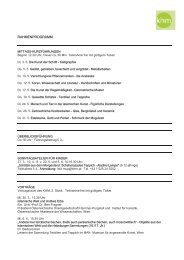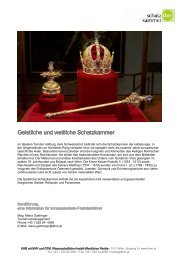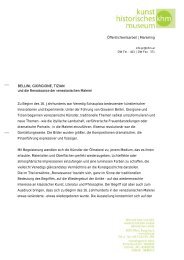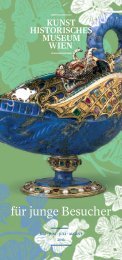Important objects - Kunsthistorisches Museum Wien
Important objects - Kunsthistorisches Museum Wien
Important objects - Kunsthistorisches Museum Wien
Create successful ePaper yourself
Turn your PDF publications into a flip-book with our unique Google optimized e-Paper software.
THE THE EMPEROR'S EMPEROR'S IVORIES<br />
IVORIES<br />
Masterpieces Masterpieces from from the the Habsburg Habsburg Kunstkammer Kunstkammer Co Collections Co llections<br />
A A SELECTION SELECTION OF OF THE THE MMOST<br />
MM<br />
OST IMPORTANT EXHIBI EXHIBITS EXHIBI<br />
TS<br />
Öffentlichkeitsarbeit | Marketing<br />
info.pr@khm.at<br />
DW Tel. - 4025 | DW Fax - 4098
ST. ST. GREGORY GREGORY WITH WITH SCRIBES<br />
SCRIBES<br />
Master of the Vienna Gregory Tablet<br />
Carolingian, 9 th century<br />
© Vienna, <strong>Kunsthistorisches</strong> <strong>Museum</strong>, inv.-no. KK 8399<br />
Pope Gregory the Great is regarded as the author of the liturgical texts spoken by the priest<br />
during Mass in the Roman Catholic Church. Charlemagne later made them obligatory<br />
throughout his newly-founded Roman Empire. Legend tells of a scribe who spied the dove<br />
of the Holy Spirit whispering the prayers in Gregory’s ear before the saint dictated them to<br />
him in aloud voice.<br />
The genius ivory carver responsible for this work retains the motif of divine inspiration but<br />
depicts the pope as an author, pausing to listen to the voice of inspiration before continuing<br />
to write. The composition is extended over two storeys and set inside the Lateran Palace.<br />
We are eye-witnesses to the divine word becoming text and its subsequent dissemination<br />
in the form of books.
SO SO-CALLED SO CALLED OLIFANT OLIFANT OF OF COUNT COUNT ALBRECHT ALBRECHT III III III OF OF HABSBURG<br />
Lower Italy (Amalfi or Salerno), 11 th century, or 1 st half of the 12 th century<br />
dedication inscription dated 1199<br />
© Vienna, <strong>Kunsthistorisches</strong> <strong>Museum</strong>, inv.-no. KK 4073<br />
Over a hundred mediaeval ivory hunting horns have survived. The oldest extant examples<br />
are Byzantine, while the decoration and some of the inscriptions on others point to their<br />
Saracen origins. “Saracens” were members of the Islamic-Arab civilisation who had settled<br />
around the Mediterranean basin. Such hunting horns were mainly Saracen (Fatimid)<br />
exports destined for members of the European aristocracy.They were highly sought-after as<br />
they were connected with the horn of Roland, who – according to the popular song of<br />
Roland – had blown his before dying to warn Charlemagne of the advancing Saracen army.<br />
However, most of the olifants were made in Lower Italy which saw the establishment of<br />
competing Latin-Christian workshops copying Fatimid-Saracen models from the 10 th<br />
century onwards. This olifant is the oldest extant artwork in the Habsburg’s collection: in<br />
1199, Count Albert III Alsace, presented the horn filled with relics to the Abbey at Muri in<br />
Switzerland.
VENUS VENUS AND AND AMOR<br />
AMOR<br />
Nikolaus Pfaff (1556? – 1612)<br />
Prague, c. 1601/07<br />
© Vienna, <strong>Kunsthistorisches</strong> <strong>Museum</strong>, inv.-no. KK 4658<br />
Ivory carving requires the specific form of collecting engendered by a Kunstkammer<br />
assembled by an appreciative connoisseur and patron. Daniel Fröschl, the imperial court<br />
antiquarian of Rudolf II, lists four ivory portraits of the emperor, as well as a number of<br />
turned ivories, by the imperial court ivory carver, Nicolaus Pfaff. They show him – in the<br />
spirit of Rudolf’s truly cosmopolitan court – competing with the late-Mannerist traditions<br />
inherent in the works of Sustris and Spranger. This creative give-and-take between the<br />
demands of the imperial patron and the artist’s mature potential led to the creation of ivories<br />
where delicate expression corresponds with a subtle composition, culminating in the<br />
exquisite refinement of virtuoso carving.
FURY<br />
FURY<br />
"Furienmeister"/Master of the Furies<br />
Salzburg?, c. 1610/20<br />
originally in the residence of the Prince-Archbishop of Salzburg<br />
© Vienna, <strong>Kunsthistorisches</strong> <strong>Museum</strong>, inv.-no. KK 3727<br />
This incredibly dynamic figure expresses the power of the period around the turn of the<br />
seventeenth century, a period marked by political, religious and social upheavals. Informed<br />
by late-Gothic expressiveness, the scrawny body seems almost torn apart by furious<br />
movement. The intensity of expression culminates in the fury’s painfully distorted face.<br />
With their emphasis on silhouette the works of the Master of the Furies serve as a<br />
precursor of Matthias Steinl’s mounted figures. This fury is one of the Master of the Furies’<br />
mature main works, which are marked by an amalgamation of motifs taken from sculpture,<br />
painting, graphic works, goldsmith-work and turned ivories. The former concentration of<br />
works by the Master of the Furies in the Kunstkammer of the Prince-Archbishops of<br />
Salzburg suggests an extended sojourn of the artist in that city.
HESPE HESPERIDIA HESPE RIDIA FEEDING FEEDING THE THE SERPENT SERPENT LADON<br />
LADON<br />
"Furienmeister"/Master of the Furies<br />
Salzburg?, c. 1610/20<br />
originally in the residence of the Prince-Archbishop of Salzburg<br />
© Vienna, <strong>Kunsthistorisches</strong> <strong>Museum</strong>, inv.-no. KK 4559<br />
In his Metamorphoses, Ovid tells of the Hesperides who guard the golden apples, the fruits<br />
of immortality and thus a great treasure, in the garden of the gods which is located on the<br />
western shore of the world ocean. Hera, however, had doubts about their reliability and had<br />
the serpent, Ladon, join them on their watch. The twelfth labour of Hercules was to bring<br />
the golden apples to King Eurystheus. .<br />
This group is a technical bravura piece – it is cut from a single tusk. The dynamic interplay<br />
between body and drapery illustrates the battle for form and space. The interaction of the<br />
two bodies enhances the contrast between the smooth skin of the human body and the<br />
serpent’s rough hide.
COVERED COVERED TANKARD TANKARD DEPICTING DEPICTING A A BACCHANAL<br />
BACCHANAL<br />
Georg Petel (1601/02 - 1634)<br />
Andreas I. Wickert (1600 - 1661)<br />
Augsburg, 1629<br />
Commissioned by Count Ottheinrich Fugger<br />
© Vienna, <strong>Kunsthistorisches</strong> <strong>Museum</strong>, inv.no. KK 4519<br />
The story of drunken Silenus, taken from classical mythology, was a popular moralizing<br />
commentary on the dangers connected with Bacchanalian pleasures such as drunkenness,<br />
lust and stupidity.<br />
The drastic rendering of the inebriated company is based on the works of Peter Paul<br />
Rubens who also executed designs for ivories. Georg Petel, one of the leading sculptors of<br />
the 1 st third of the 17 th century, cleverly transposed motifs taken from his Flemish friend’s<br />
paintings into a convincing sculptural composition of powerful images. The simple metal<br />
setting was commissioned by Count Ottheinich Fugger. It turns the sculpture into a<br />
functional drinking vessel though it was probably never used as such.
SATYR SATYR AND AND AND THE THE THE NYMPH NYMPH CORISCA CORISCA<br />
Adam Lenckhardt (1610 - 1661)<br />
Vienna, 1639<br />
signed and dated<br />
inspired by a scene from the pastoral melodrama "Il Pastor fido" by G.B. Guarini<br />
© Vienna, <strong>Kunsthistorisches</strong> <strong>Museum</strong>, inv.-no. KK 4564<br />
The foolish Satyr approaches his former lover from behind to punish her for her infidelity.<br />
But when he attempts to grab the nymph by her lush hair he is fooled once more. Surprised,<br />
he almost falls backwards while Corisca flees, making fun of her duped lover with obscene<br />
gestures. The clarity of the depictions, the unembellished realism evidenced in the<br />
modeling of the bodies, and the narrative power of the scene make this original composition<br />
unique. Lenckhardt’s small sculptures cut from ivory or rhinoceros’ horn document the<br />
influence of contemporary Venetian and southern-German/Austrian sculpture. From 1642<br />
onwards Lenckhardt was court sculptor to Karl Eusebius of Liechtenstein in Vienna.
APOLLO APOLLO AND AND DAPHNE<br />
DAPHNE<br />
Jakob Auer (c. 1645 - 1706)<br />
Vienna, c. 1688/90<br />
© Vienna, <strong>Kunsthistorisches</strong> <strong>Museum</strong>, inv.-no. KK 4537<br />
In his Metamorphoses, Ovid tells of the nymph, Daphne, whom Diana saves from Apollo’s<br />
amorous advances by turning her into a laurel tree. Jacob Auer’s starting point was<br />
Bernini’s celebrated marble group but his for him the story is mainly an excuse for virtuoso<br />
carving. The smooth perfection of the two bodies and the elaborate carving of foliage and<br />
draperies emphasise the decorative virtuoso qualities of this show-piece that perfectly<br />
documents the artist’s ability to transcend the tusk’s natural form.<br />
Various 17th and 18th century travel diaries single out this group from the host of ivory<br />
works in the Imperial treasury.
COVERED COVERED TANKARD TANKARD WITH WITH FLOWERS<br />
FLOWERS<br />
southern Germany, 1 st third of the 17 th century<br />
© Vienna, <strong>Kunsthistorisches</strong> <strong>Museum</strong>, inv.-no. KK 4777<br />
This covered tankard is a characteristic example of the turned ivories popular in the early<br />
17 th century which saw the beginning of a move away from the simpler, stereometric basic<br />
forms featuring empty spaces to the much more complex formal speculations popular in the<br />
1610’s. Both artists and collectors were fascinated by machines and this led in the late 16 th<br />
century to the development of such show-pieces in which nature is surmounted by human<br />
creativity – ars naturam superat.<br />
This tankard may have been in the collection of the Emperor Rudolf II whose inventories list<br />
a comparable becherlin (mug) or blumenkrug mit vilen blumen (flower-ewer with many<br />
flowers).
SET SET SET OF OF TURNED TURNED IVORY IVORY WORKS WORKS<br />
WORKS<br />
Marcus Heiden (tätig 1618 - 1664)<br />
Johann Eisenberg (1600 - 1640)<br />
Coburg, c. 1630/37<br />
© Vienna, <strong>Kunsthistorisches</strong> <strong>Museum</strong>, KK 4671, KK 4676, KK 4772, KK 4777<br />
In the late 16 th century it became fashionable at some courts to make gifts of ivory <strong>objects</strong><br />
d’art. This selection of turned ivories documents the stylistic variety, complex geometry and<br />
bizarre artificiality of these ivory <strong>objects</strong> d’art turned on a lathe. These magnificent<br />
examples of human ingenuity and craftsmanship were collected as examples of the<br />
material application of geometry in technical achievements.<br />
This made these precious creations perfect show-pieces for a princely Kunstkammer,<br />
where a contemporary encyclopedic love of collecting aimed at displaying the wealth of<br />
human knowledge. Turning ivory on a lathe was both important from an art-theoretical point<br />
of view and highly challenging considering the limits imposed by the fragility of the material.<br />
At the time, turning ivory on a lathe was also included in the education of princes.
STANDING STANDING HOLLOW HOLLOW SPHERE<br />
SPHERE<br />
Lorenz Zick (1594 - 1666)<br />
Nuremberg, 2 nd third of the 17 th century<br />
ivory, shell cameos, gouache on paper<br />
© Vienna, <strong>Kunsthistorisches</strong> <strong>Museum</strong>, inv.-no. KK 4503<br />
Hollow standing spheres based on complex mathematical calculations are among the most<br />
challenging turned ivory <strong>objects</strong>. The virtuosity of the artist was greatly admired by all who<br />
saw them, making them highly sought-after princely gifts. Within a hollow sphere these<br />
turned <strong>objects</strong> d’art contain additional geometric shapes or a capsule enclosing miniature<br />
portraits. Ribbons attached to the sides make it possible to open the capsule and admire<br />
the portraits through a slightly-larger opening. Shell cameos on a globe born by Hercules<br />
are a reference to the world-encompassing empire ruled by the House of Habsburg, and<br />
depict Habsburg rulers from Rudolf I to Ferdinand III.
BACCHANAL<br />
BACCHANAL<br />
Johann Ignaz Bendl (active before 1682 - 1730)<br />
Vienna, signed and dated Ignati bendl f. 1684<br />
© Vienna, <strong>Kunsthistorisches</strong> <strong>Museum</strong>, inv.-no. KK 3655<br />
This series of twelve framed mythological scenes cut from the interior wall of an ivory tusk<br />
in 1684 is considered the earliest dated work by Johann Ignaz Bendl. The nude male figure,<br />
cut in-the-round, elegantly doing a handstand documents the virtuoso aspect of these ivory<br />
reliefs designed for a decorative over-all impression. Such virtuoso ivory <strong>objects</strong> had no<br />
practical purpose but were composed as show-pieces to be displayed together with<br />
paintings; occasionally they were also used to decorate important pieces of furniture.
EMP EMPEROR EMP EROR LEOPOLD I. I. MOUN MOUNTED MOUN<br />
TED TED ON ON HIS HIS<br />
CHARGER<br />
CHARGER<br />
Matthias Steinl (1643/44 - 1727)<br />
Vienna, c 1690/93<br />
© Vienna, <strong>Kunsthistorisches</strong> <strong>Museum</strong>, inv.-<br />
no. KK 4662<br />
EMPEROR EMPEROR EMPEROR JOSEPH JOSEPH I I MOU MOUNTED MOU MOUNTED<br />
NTED ON HIS<br />
CHARGER<br />
CHARGER<br />
Matthias Steinl (1643/44 - 1727)<br />
Vienna, 1693<br />
signed and dated<br />
© Vienna, <strong>Kunsthistorisches</strong> <strong>Museum</strong>, inv.-<br />
no. KK 4663<br />
Together with its companion piece depicting King Joseph I vanquishing Fury, the statuette<br />
of Emperor Leopold I as victor over the Turks and the French is an allegorical monument.<br />
This ambitious project deals less with the glorification of the emperor and his eldest son<br />
than with illustrating the divinely-endorsed rule of the House of Habsburg and the<br />
continuation and renewal of the Imperium Romanum under the present and future rulers of<br />
the Holy Roman Empire.<br />
However, it was never planned to transpose the statuettes into a more monumental format,<br />
they were always intended as indoor show-pieces to be displayed in the Imperial Treasury.<br />
There they were first singled out as a rare highlight among the city’s sights in 1715. The<br />
double-monument was commissioned after the election and coronation of Joseph I as<br />
Roman King and the subsequent festive entry into Vienna of the imperial father and his son.<br />
Here, Steinl, the imperial court ivory-carver, documents his eminent virtuosity by executing<br />
two small-scale monumental mounted statues; the consummate handling of delicate details
is breathtaking. However, the work’s incredibly complex political-historical meaning raises<br />
its importance above mere formal questions and makes it a unique monument of imperial<br />
propaganda. Leopold is characterized as the victorious general and imperator, the<br />
defender of his realm and of Christianity, his son as one of the horsemen of the<br />
Apocalypse. These ivory statuettes are the only mounted statues of the two rulers executed<br />
during Leopold’s reign in the imperial capital of Vienna.
ST. ST. MICHEAL MICHEAL VANQUISHING VANQUISHING SATAN<br />
SATAN<br />
Johann Schnegg (1724 - 1784)<br />
Bayreuth (?), c. 1740/60<br />
ivory, wood<br />
© Vienna, <strong>Kunsthistorisches</strong> <strong>Museum</strong>, inv.-no. KK 4572<br />
Combined figures – figures executed partly in ivory and partly in wood – were a fashion in<br />
late-baroque small-scale sculpture.<br />
This composition is informed by Jesuit spirituality and didactically contrasts humility and<br />
arrogance. St. Michael, the personification of good, is depicted in brilliantly-white ivory; he<br />
is shown triumphing over Lucifer, the fallen angel, who personifies evil and the dark powers<br />
and is rendered in dark wood. The ivory clouds hovering above the globe emphasize the<br />
triumph of the divine powers.<br />
The cool smoothness of the highly type-cast figurative group is a reference to the porcelain<br />
figures of the later 18 th century that began to replace ivory as the material of choice for<br />
small-scale statues.


